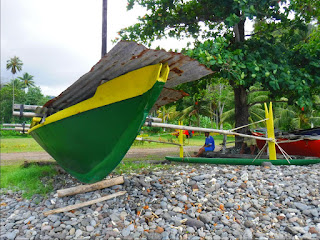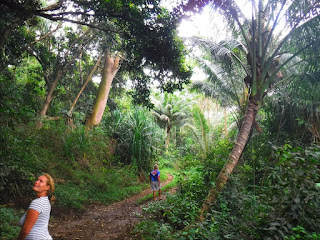After
exploring the tiki village, we went down to the beach to have some
lunch. On the East end of the bay of Puamau is this large vertical
rock peak. And a covered area with a quay for loading boats.
Looking
down the beach to the West towards the village, kids are playing in
the surf.
The
beach where we are having lunch has this lovely spot of sand and a
spring running down into the bay.
The
rocks are interesting as each piece of lava rock is outlined with
iron, making designs in the big bolder.
The
surf wooshes as the swell recedes from the beach to between the
rocks.
As
the next wave comes, the water covers our sandy spot.
Then
it drains out again.
The
peak with the surf breaking under makes for a lovely lunch spot!
This
coconut looks like it has grown long hair, but it is from the husk
being degraded in the surf.
This
one has really long hair and an open mouth as if to say, “whoa
dude”!
The
spring just bubbles out of the sand and the fresh water runs right
into the salty ocean.
I
am facinated with the swirls of the sand as each wave comes and goes.
Brown,
white and black sand all mixing together. Wish people could do that!
Each
thing that lands in the sand causes another sand design to be formed.
This
is a Portuguese Man of War jelly fish. Quite dangerous, so glad I
noticed him washed up on the beach and did not step on him!
Chris
is studying the hole in the sand where the water washes in.
Debating if he wants to get in.
Layers
and layers of stone have been washed away from the ocean created hole
in the rock.
Chris
and Zane figure out that the hole in the sand is deep enough to go
for a swim.
Amazing
actually how deep that hole was, but what a lovely setting for taking
a dip!
Mike
and I pose with the rock pinnacle behind us.
On
the way back up the mountain we run into serious fog!
Lucky
for us it is not too thick and we can find our way as the road turns
from paved to dirt again.
The
Clouds sit on top of the backbone peak of Hiva Oa, creating a cloud
forest.
On
the way back we took a detour down to Hanaiapa Bay. This is a pencil
Urchin which I had never seen in its entirety. Only found its spines
before.
The
bottom side still had all of the little purple and orange spines, but
nothing left but the outer shell. Someone must have eaten him.
Bay
Hanaiapa has black sand with rock chunks scattered around.
Pulled
up high on the beach were several dug out outrigger canoes. This guy
puts corrugated roofing over his to keep the rain water out.
Roca
Fatutue is beautifully framed by the tree on the beach.
Some
of the rope detail of how the outrigger is attached to the dugout
canoe.
Several
women were fishing in the stream just before it dumped into the bay.
Mike watched the lady in yellow catch 3 fish in the short time we
were there.
Another
small creek runs along the plant lined road as we drive back towards
the center of the island.
They
build these planter boxes for growing seedlings. Great soil here!
This
Soursap fruit looked like a face protruding from inside! Creepy!
We
followed a blocked off dirt track on foot through the jungle looking
for the smiling tiki.
Trees
are fighting for sunlight, so they have long trunks to get above the
other plants.
Deep
in the forest the roots of these trees are seaching for water, while
still holding up the trees on the small ledge.
Banana
tree and other thick foliage.
The
roots of the Chestnut tree are thin and skinny where they stick up
from the ground.
Finally
we find the smiling tiki. Looks like he must be smart with glasses
on too?
He
was no so easy to find, just a carved rock sticking up above the
ground cover.
We drive back toward Atuona, stopping to enjoy the views as they popped
into view.
Looking
back at the boat yard and the bay of Tahuku where our boats are
anchored.
At
the far end of Taaoa (Traitor's) Bay is the village of Taaoa with
this beautiful old stone church.
Looked
like the roof had recently been replaced and the plants on the side
are to keep away the evil spirits. People were inside singing too. Quite magical.
Kids
were playing in Superman's phone booth with the missing glass. Hello
tourists!!
We
found one more ancient Archaeological site called Tohua Upeke. This
was a huge site with many many rocks outlining the more than 1000
different platforms.
Not
sure if this drawn tiki face is new or old, or just newly outlined
from an old carving.
Mike
poses by some of the many different levels of stone work.
This
area did not have much growth and had rock outlines that made it look
like a ball court.
At
the far end of the court was this circular symmetrical pattern that
the plant life is trying to take over. There is a fairly deep hole
in the center.
Looking
back the other direction of the ball court.
This
huge sacred Banyan tree is behind and leads to another area of the
site.
In
the very back was one more ancient carved tiki. This one just barely
shows the carvings because of erosion.
The
sacred tea leaf plants line the path to the tiki.
I
noticed several snail shells wondering around the place.
Two
holes in a rock. Were they caused by dripping water or were they
where someone pounded out seeds or plants a 1000 years ago?!?
This
was a real live snail still scouting about the place.
The
sign is a bit hard to read, but is very interesting. Here's what it
says: The valley of Ta'a Oa is one of the most imporant of the
island, both for its size and population. At one time it was made up
of numerous clans including that of the Tiu, which was considered as
a founding clan (tumu) of most of the ancient clans of Hiva Oa.
A
beautiful legend translates the legendary importance of this valley
in the mythical settlement of the Marquesas. Long ago here there was
a marvellous tree on which all the birds of the Marquesas lived. One
day it broke and where the branches touched the different islands it
gave to each a particular bird.
This
very complex center, delimited in the interior by small walls (hi'i
hoika) include habitation sites, communal places such as a tohua, at
least two me'ae and 'ua ma pits <must be the hole in the center of
the stones>
The
Me'ae is considered above all as a sacred place. Always tapu (taboo)
that is to say, the access is forbidden or reserved for people of
very high mana (energy). This was especially the case during ritual
periods. The term me'ae actually designates different places and
constructions. In the first place, it corresponds both to a funerary
site of high king lineages and to places where they would leave bones
belonging to a clan. The me'ae was the place where the most
important ritual prayers were performed, where the first rocolots
were offered and where the most significant offerings were raised,
thus this was the place where the human victims were laid, either
before or after their exposition on the tohua. Men, would they be
priests or chiefs, warriors or even special artisans would seldom go
there.
There
were at least two constructions. One was for ordinary priests (fa'e
or tukaka)< your kaka?!? I would never say that to a priest!>
And another for the high priests. Sometimes there would even be a
third building designed to shelter a few ritual items.
The
statue or tiki found on these places were very sacred. They
incarnated prestigious personalities who were raised to the rand of
deified ancestors.
Their
idea of what the structures looked like that are long gone from the
stone foundations.
It
was a long day, driving from one end of the 23 mile island to the
other all in daylight hours. The views and education were amazing!
Thank God we had Mike to drive the car for us! When we dropped off
the car they drove us back to our boats. Great service!



























































